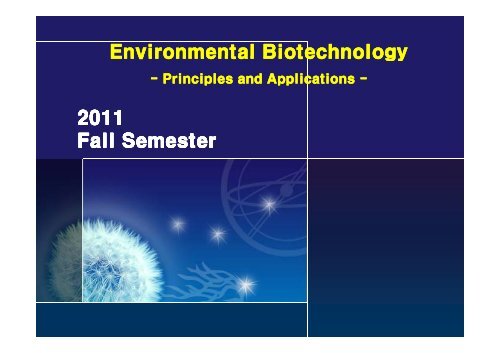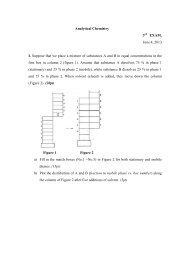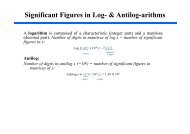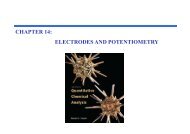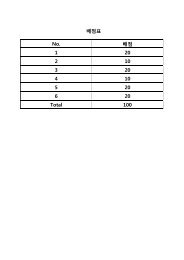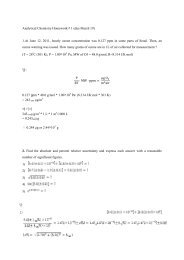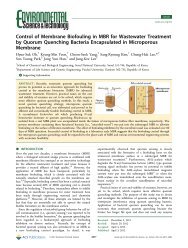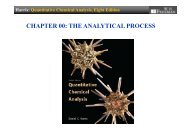Environmental Biotechnology: Principles and Applications - WEMT
Environmental Biotechnology: Principles and Applications - WEMT
Environmental Biotechnology: Principles and Applications - WEMT
Create successful ePaper yourself
Turn your PDF publications into a flip-book with our unique Google optimized e-Paper software.
<strong>Environmental</strong> <strong>Biotechnology</strong><br />
2011<br />
Fall Semester<br />
- <strong>Principles</strong> <strong>and</strong> <strong>Applications</strong> -<br />
2003. 7
2012학년도 2학기<br />
환경생물공학 (458.408) 408)<br />
Seoul National University<br />
<strong>WEMT</strong>
• 교과목명 : 환경생물공학<br />
• 교과목 번호 : 458.408<br />
• 수강대상 : 학부 3,4학년 (또는 대학원생)<br />
• 선수 권장과목 : 공학생물<br />
• 담당교수 : 이정학 (leech@snu.ac.kr / 302동810호 / 880-7075)<br />
• 교과목 홈페이지 : http://wemt.snu.ac.kr<br />
• 강의시간 : 화,목 11:00~12:15<br />
• 강의실 : 302동 808호<br />
• 강의조교 : 조성준 (josungjun@snu.ac.kr / 302동 515호 / 880-8280)<br />
• 상담시간 : 목 PM 13:30~14:30<br />
Seoul National University<br />
<strong>WEMT</strong>
• 목표<br />
미생물을 이용한 수처리 시스템의 원리를 파악하고, 시스템을 설계할 수 있는 능력을 배양한<br />
다.<br />
• 개요<br />
미생물을 이용하여 오염물에 의한 자연환경의 질 악화를 예방하거나 에너지를 회수하는 기<br />
술을 다룬다. 공학(반응공학, 유체역학)을 미생물학, 분자생물학과 접목하여 폐수, 토양으로<br />
부터 유기물, 질소, 인 등의 오염물 제거, 메탄가스 생성, 음용수에서 미량독성물질 제거 등을<br />
강의한다.<br />
•교재 및 참고서<br />
Bruce E. Rittmann <strong>and</strong> Perry L. McCarty<br />
"<strong>Environmental</strong> <strong>Biotechnology</strong>: <strong>Principles</strong> <strong>and</strong> <strong>Applications</strong>“, McGraw-Hill, 2001.<br />
C.P.Leslie Grady, Jr.<br />
" Biological Wastewater Treatment", 3rd edition,CRC Press, 2011<br />
Seoul National University<br />
<strong>WEMT</strong>
주 강의내용 장 비고<br />
1 Introduction & Basics of Microbiology 1<br />
2 Basics of Microbiology & Stoichiometry <strong>and</strong> Bacterial Energetics 2<br />
3 No Class<br />
4 Stoichiometry <strong>and</strong> Bacterial Energetics / Microbial Kinetics 2 / 3<br />
9/18 (화)<br />
No Class<br />
9/20 (목)<br />
No Class<br />
5 Microbial Kinetics / Biofilm in the water industry 3 / 4<br />
6 The Activated Sludge Process 5<br />
7 The Activated Sludge Process 5<br />
10/16 (화)<br />
Mid-term Exam<br />
8 The Activated Sludge Process 5<br />
9 Nitrification <strong>and</strong> Denitrification 7<br />
10 Phosporous Removal 8<br />
11/8 (목)<br />
No Class<br />
11 Anaerobic Treatment 9<br />
12 Membrane Bio-Reactor (MBR) 10<br />
13<br />
Membrane Bio-Reactor (MBR) / Biological Treatment of Soil<br />
Contaminants<br />
10 / 11<br />
14<br />
12/4 (화)<br />
No Class<br />
12/6 (목)<br />
Final Exam
• 휴강 및 보강<br />
9/18 휴강<br />
9/20 휴강<br />
11/8 휴강<br />
12/4 휴강<br />
10/5 보강<br />
11/30 보강 (금요일 오후 3시간)<br />
• 시험 일정<br />
10/16 중간고사<br />
12/6 기말고사<br />
• 평가 기준<br />
시험 (85%)<br />
과제 & 보고서 (10%)<br />
출석 & 수업태도 (5%)<br />
Seoul National University<br />
<strong>WEMT</strong>
Chapter 0. Introduction<br />
<strong>Environmental</strong> <strong>Biotechnology</strong>:<br />
The suffix, “bio” indicates that we are exclusively concerned about living things<br />
1) Apply the principles of microbiology to the solution of<br />
environmental problems<br />
2) A linking of the principles of microbiology with<br />
engineering fundamentals involving reaction kinetics &<br />
engineering <strong>and</strong> conservation of energy & mass<br />
3) The major difference between environmental<br />
biotechnology <strong>and</strong> other disciplines that feature<br />
biotechnology : <strong>Environmental</strong> applications almost<br />
always are concerned with mixed culture, open,<br />
nonsterile systems.
Chapter 0. Introduction<br />
<strong>Environmental</strong> <strong>Biotechnology</strong>:.<br />
4) Success depends on :<br />
i) How individual microorganisms with desired<br />
characteristics can survive in competition with other<br />
organisms.<br />
ii) How desired functions can be maintained in complex<br />
ecosystems.<br />
iii) How the survival <strong>and</strong> proliferation of undesired<br />
microorganisms can be prevented. ( ex.; Filamentous<br />
bacteria in Activated Sludge Process) )
Chapter 0. Introduction<br />
<strong>Applications</strong> in <strong>Environmental</strong> Microbiology<br />
include:<br />
1) Treatment of industrial <strong>and</strong> municipal wastewaters<br />
2) Enhancement of the quality of drinking water<br />
3) Restoration of industrial, commercial, residential, <strong>and</strong><br />
government sites contaminated with hazardous materials.<br />
4) Prevention of the spread through air or water of pathogens<br />
among human <strong>and</strong> other species.
Chapter 0. Introduction<br />
<strong>Applications</strong> in <strong>Environmental</strong> Microbiology<br />
include:<br />
5) Production of environmentally benign (friendly) chemicals.<br />
6) Reduction in industrial residuals in order to reduce resource<br />
consumption <strong>and</strong> the production of pollutants requiring disposal.<br />
7) Protection ti or restoration ti of rivers, lakes, estuaries, <strong>and</strong> coastal<br />
waters from environmental contaminants (Eutrophication; N, P<br />
removal)


